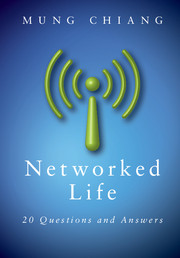Book contents
- Frontmatter
- Contents
- Preface
- Acknowledgements
- Roadmap
- 1 What makes CDMA work for my smartphone?
- 2 How does Google sell ad spaces?
- 3 How does Google rank webpages?
- 4 How does Netflix recommend movies?
- 5 When can I trust an average rating on Amazon?
- 6 Why does Wikipedia even work?
- 7 How do I viralize a YouTube video and tip a Groupon deal?
- 8 How do I influence people on Facebook and Twitter?
- 9 Can I really reach anyone in six steps?
- 10 Does the Internet have an Achilles' heel?
- 11 Why do AT&T and Verizon Wireless charge me $10 a GB?
- 12 How can I pay less for each GB?
- 13 How does traffic get through the Internet?
- 14 Why doesn't the Internet collapse under congestion?
- 15 How can Skype and Bit Torrent be free?
- 16 What's inside the cloud of iCloud?
- 17 IPTV and Netflix: How can the Internet support video?
- 18 Why is WiFi faster at home than at a hotspot?
- 19 Why am I getting only a few % of the advertised 4G speed?
- 20 Is it fair that my neighbor's iPad downloads faster?
- Index
- Notes
11 - Why do AT&T and Verizon Wireless charge me $10 a GB?
Published online by Cambridge University Press: 05 November 2012
- Frontmatter
- Contents
- Preface
- Acknowledgements
- Roadmap
- 1 What makes CDMA work for my smartphone?
- 2 How does Google sell ad spaces?
- 3 How does Google rank webpages?
- 4 How does Netflix recommend movies?
- 5 When can I trust an average rating on Amazon?
- 6 Why does Wikipedia even work?
- 7 How do I viralize a YouTube video and tip a Groupon deal?
- 8 How do I influence people on Facebook and Twitter?
- 9 Can I really reach anyone in six steps?
- 10 Does the Internet have an Achilles' heel?
- 11 Why do AT&T and Verizon Wireless charge me $10 a GB?
- 12 How can I pay less for each GB?
- 13 How does traffic get through the Internet?
- 14 Why doesn't the Internet collapse under congestion?
- 15 How can Skype and Bit Torrent be free?
- 16 What's inside the cloud of iCloud?
- 17 IPTV and Netflix: How can the Internet support video?
- 18 Why is WiFi faster at home than at a hotspot?
- 19 Why am I getting only a few % of the advertised 4G speed?
- 20 Is it fair that my neighbor's iPad downloads faster?
- Index
- Notes
Summary
A Short Answer
Almost all of our utility bills are based on the amount we consume: water, electricity, gas, etc. But even though wireless cellular capacity is expensive to provide and difficult to crank up, consumers in some countries like the USA have been enjoying flat-rate buffets for mobile Internet access for many years. Can a restaurant keep offering buffets with the same price if its customers keep doubling their appetites every year? Or will it have to stop at some point?
In April 2010, AT&T announced its usage-based pricing for 3G data users. This was followed in March 2011 by Verizon Wireless for its iPhone and iPad users, and in June 2011 for all of its 3G data users. In July 2011, AT&T started charging fixed broadband users on U-Verse services on the basis of usage too. In March 2012, AT&T announced that those existing customers on unlimited cellular data plans will see their connection speeds throttled significantly once the usage exceeds 5 GB, effectively ending the unlimited data plan. The LTE data plans from both AT&T and Verizon Wireless for the “new iPad” launched soon after no longer offered any type of unlimited data options. In June 2012, Verizon Wireless updated their cellular pricing plans. A customer could have unlimited voice and text in exchange for turning an unlimited data plan to usage-based. AT&T followed with a similar move one month later. What a reversal going from limited voice and unlimited data to unlimited voice and limited data. Similar measures have been pursued, or are being considered, in many other countries around the world for 3G, 4G, and even wired broadband networks.
- Type
- Chapter
- Information
- Networked Life20 Questions and Answers, pp. 235 - 255Publisher: Cambridge University PressPrint publication year: 2012



